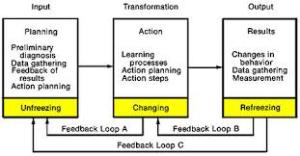When a new Fire Chief is sworn in, the buzz around the fire station is what he/she is going to change. If the new Chief is coming from outside the organization the rumor and questions increase exponentially. So as the new Chief are you a change agent; do you understand the organizational implication of change?
A good working definition of a change agent is someone that is able to alter an organizational system to achieve a higher degree of output without disrupting the operations of the organization.
A change agent should have the following attributes;
• Clear Vision
• Patience
• Leads by Example
• Includes other is the Vision-Team Builder
Below we will examine each of the attributes of change agent.
Clear Vision-Ralph Waldo Emerson said” People only see what they are prepared to see,” but to be a true change agent one must be able to see past what they want to see, be able to see the entire picture globally, and have the ability to communicate that vision clearly. The change agent must also understand that there is more than one way to accomplish things. It is essential to utilize the strengths of others, your executive team to start with, to work towards a common goal: the change vision.
Patience-It is said that patience is a virtue and never is this statement more true than when it comes to acting as a change agent. Change is very hard work. It takes time and energy to accomplish it. There are times that the change agent will be misunderstood and even miss-appreciated. Remember you are changing the status quo of the organization that most of the member are very comfortable working with. The knowledge that the end result will be a better and stronger organization is the driver that the change agent must use. It takes patience and by moving too fast the entire process can be derailed resulting in a negative impact to the organization.
Lead By Example-Chief Dennis L. Rubin former Chief of Washington DC Fire and EMS Department in his e-book “Rubes Rules for Leadership” has a chapter titled “Lead from the Front-To be Effective, Be Sure Your Actions Match Your Words.” Chief Rubin explains that everyone in your organization is watching you; you have to consistent in your decision and actions. If you are leading from the front, or using the cliché “Walking the Walk and Talk the Talk” you will gain creditability within your organization and any change you want to make will be easier in the long run. If you are not leading from the front, the change is doomed to failure and you will lose creditability within your organization.
On my desk was a small plaque from Apollo 13 Moon Mission, it simpley says ”Failure is Not an Option.” If during that mission Commander Jim Lovell was not up front and leading by example the outcome of the mission could have gone tragically different.
Chief Rubin ends the section on Leading from the Front with the following statement, “Always remember that someone is watching you. Whether it is the public, the media or your own people, they are watching.” As a change agent for your organization, you must lead by example to have the creditability and support of the member to accomplish any change.
Including Others in the Vision, Team Builder-Including others in the vision and building your team is the final and one of the most important concepts of change. The change agent or in this case the Fire Chief must excite the team, the executive staff, and gain the commitment of the team to follow through with the process of change. To accomplish this the change agent must appeal to the team the need for change, the positive aspects of the change for the organization and the members of the department, this is accomplished by:
• Understanding what each member brings to the organization.
• Leverage these talents to improve the department.
• Develop excitement in the process, request input, and be flexible to adjust the vision if needed.
• Provide recognition to the team members for their input
• Foster excitement by leading from the front.
• Be patient, change take time. Moving too fast will slow the change and foster resentment from the members.
The final part of acting as a change agent is the action phase. Announce the change plan to the organization and work with the membership to foster and implement the change. Remember you will have to review and at time start over to accomplish the end result of a more effective organization.

